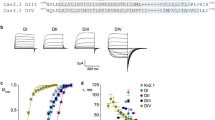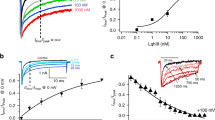Abstract
Many toxic compounds alter specifically the functioning of the fast sodium conductance that is responsible for the generation of action potentials in neuronal and muscle cells. One important class of these compounds consists of the lipid-soluble toxins, such as veratridine and other ceveratrum alkaloids, batrachotoxin, aconitine, and the diterpenoid grayanotoxins. These molecules are thought to bind to a common receptor site on the Na+ channel1–5, thus inducing a membrane depolarization which can be suppressed by the addition of tetrodotoxin (TTX) or by the removal of Na+ from the incubation medium3. We show here that this family of molecules is not specific for the Na+ channel in neuroblastoma cells. Blockade of the voltage-dependent calcium channel is also observed, either in the toxin concentration range in which the molecules act on the Na+ channel (veratridine, grayanotoxin) or at even lower concentration (batrachotoxin).
Similar content being viewed by others
References
Narahashi, T. Physiol. Rev. 54, 813–889 (1974).
Albuquerque, E. X. & Daly, J. W. in The Specificity and Action of Animal, Bacterial and Plant Toxins (ed. Cuatrecasas, P.) 299–338 (Chapman & Hall, London, 1976).
Ulbricht, W. Ergebn. Physiol. 61, 18–71 (1969).
Lazdunski, M. et al. in Neurotransmitters and their Receptors (eds Littauer, U. Z., Dudai, Y., Silman, I., Teichberg, V. I. & Vogel, Z.) 511–529 (Wiley, New York, 1980).
Catterall, W. A. J. biol. Chem. 250, 4053–4059 (1975).
Moolenaar, W. H. & Spector, I. J. Physiol., Lond. 292, 307–323 (1979).
Jacques, Y., Fosset, M. & Lazdunski, M. J. biol. Chem. 253, 7383–7392 (1978).
Jacques, Y., Romey, G., Cavey, M. T., Kartalovski, B. & Lazdunski, M. Biochim. biophys. Acta 600, 882–897 (1980).
Brown, G. B. et al. Cell molec. Neurobiol. 1, 19–40 (1981).
Lee, K. S., Akaike, N. & Brown, A. M. J. gen. Physiol. 71, 489–508 (1978).
Author information
Authors and Affiliations
Rights and permissions
About this article
Cite this article
Romey, G., Lazdunski, M. Lipid-soluble toxins thought to be specific for Na+ channels block Ca2+ channels in neuronal cells. Nature 297, 79–80 (1982). https://doi.org/10.1038/297079a0
Received:
Accepted:
Issue Date:
DOI: https://doi.org/10.1038/297079a0
- Springer Nature Limited
This article is cited by
-
Veratridine produces distinct calcium response profiles in mouse Dorsal Root Ganglia neurons
Scientific Reports (2017)
-
Comparison of fluorescence probes for intracellular sodium imaging in prostate cancer cell lines
European Biophysics Journal (2016)
-
Voltage-gated Na+ Channel Activity Increases Colon Cancer Transcriptional Activity and Invasion Via Persistent MAPK Signaling
Scientific Reports (2015)
-
Calcium channels: Molecular pharmacology, structure and regulation
The Journal of Membrane Biology (1988)





